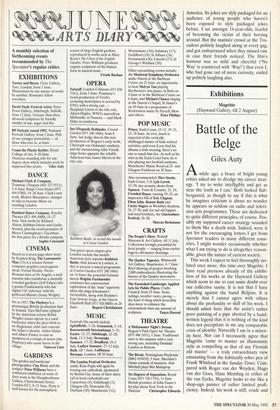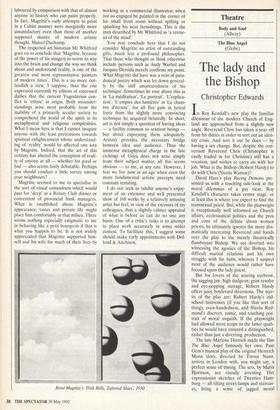Exhibitions
Magritte (Hayward Gallery, till 2 August)
Battle of the Belge
Giles Auty
Awhile ago, a brace of bright young critics asked me to divulge my career strat- egy. 'I try to write intelligibly and get as near the truth as I can.' Both looked flab- bergasted, as though to say if this is what he imagines criticism is about no wonder he appears so seldom on radio and televi- sion arts programmes. These are dedicated to quite different principles, of course. Pos- sibly my supposed career strategy sounded to them like a death wish. Indeed, were it not for the encouraging letters I get from Spectator readers in many different coun- tries, I might wonder occasionally whether what I am trying to do is altogether reason- able, given the nature of current society.
This week I expect to feel thoroughly iso- lated once more, this time over Magritte. I have read previews already of the exhibi- tion of his works at the Hayward Gallery which seem to me to cast some doubt over our collective sanity. It is not that I have anything against the banal Belgian. It is merely that I cannot agree with others about the profundity or skill of his work. I should admit here that the artist's rather poor painting of a pipe abetted by a hand- written legend that it is nothing of the kind does not precipitate in me any comparable crisis of identity. Naturally I am in a minor- ity here. Nor can I necessarily agree that Magritte 'came to master an illusionistic style as compelling as that of any Flemish old master' — a truly extraordinary view emanating from the habitually sober pen of Frank Whitford in the Sunday Times. Com- pared with Roger van der Weyden, Hugo van der Goes, Hans Memling or either of the van Eycks, Magritte looks to me like a shop-sign painter of rather limited profi- ciency. Indeed, his work is stiff, crude and
laboured by comparison with that of almost anyone in history who can paint properly. In fact, Magritte's early attempts to paint in a Cubist manner were marginally more unsatisfactory even than those of another supposed master of modern artistic thought, Marcel Duchamp.
The respected art historian Mr Whitford goes on to conclude that `Magritte, because of the power of his imagery to worm its way into the brain and change the way we think about and understand reality, is one of the greatest and most representative painters of modern times'. This is a no more out- landish a view, I suppose, than the one expressed currently by editors of esteemed dailies that the current Yugoslavian con- flict is 'ethnic' in origin. Both misunder- standings arise most probably from the inability of a primarily secular society to comprehend the world of the spirit in its metaphysical and religious complexities. What I mean here is that I cannot imagine anyone with the least pretensions towards spiritual enlightenment whose understand- ing of 'reality' would be affected one iota by Magritte. Indeed, that the art of this century has altered the conception of reali- ty of anyone at all — whether for good or bad — also seems fairly debatable. Perhaps you should conduct a little survey among your neighbours?
Magritte seemed to me to specialise in the sort of visual conundrum which would pass for 'deep' at a Rotary Club dinner or convention of provincial bank managers. What is established about Magritte's appearance, tastes and private life might place him comfortably in that milieu. There seems nothing especially enigmatic to me in behaving like a petit bourgeois if that is what you happen to be. It is not widely appreciated that Magritte supported him- self and his wife for much of their lives by working as a commercial illustrator; when not so engaged the painted in the corner of his small front room without spilling or splashing his neat furnishings. This is the man described by Mr Whitford as 'a terror- ist of the mind'.
You may conclude here that I do not consider Magritte an artist of outstanding gifts, much less a profound philosopher. That those who thought or think otherwise include persons such as Andy Warhol and Jacques Derrida merely confirms my point. What Magritte did have was a vein of para- doxical poetry which was let down general- ly by the stiff amateurishness of his technique. Sometimes he rose above this as in `La meditation', 'Le portrait', `L'explica- tion', `L'empire des lumieres' or La cham- bre d'ecoute', for all five gain in lyrical force from the slightly more convincing technique he acquired belatedly. In short, art is not simply a question of having ideas — a facility common to sentient beings but about expressing them adequately. Artistry provides the necessary bridge between idea and audience. Thus the immense metaphysical charge in the late etchings of Goya does not arise simply from their subject matter; all this seems obvious — to me, at any rate. However, I fear we live now in an age when even the more fundamental artistic precepts need constant restating.
I do not seek to inhibit anyone's enjoy- ment of an extensive and well presented show of 168 works by a relatively amusing artist but feel, in view of the excesses of my colleagues, that a slightly calmer appraisal of what is before us can do no one any harm. One of a critic's tasks is to attempt to place work accurately in some wider context. To facilitate this, I suggest some should make early appointments with Dol- lond & Aitchison.
Rene. Magritte's 'Pink Bells, Tattered Skies', 1930

















































 Previous page
Previous page